Why Major League Baseball is exploring potential revenue and sponsorship opportunities in the metaverse

On July 8, Major League Baseball is launching its first virtual stadium, an initiative internally known as MLB’s “31st Ballpark.”
By giving fans digital access to events such as this weekend’s annual Celebrity Softball Game, the league is aiming to use this virtual space as a springboard for new revenue opportunities — and, eventually, as marketing and advertising inventory in its own right.
MLB’s virtual stadium was built by the metaverse technology company Improbable and can be accessed on the league’s website via standard web browsers. Users can dress their avatars in virtual jerseys, then pilot them around the ballpark to participate in virtual activities such as a scavenger hunt for digital collectibles and events including a watch party for the Celebrity Softball Game, replete with celebrity interviews exclusive to the space.
Major League Baseball isn’t planning to make any money from this weekend’s launch, but the way the event is playing out makes it clear that the league is building its virtual ballpark with potential revenue streams in mind.
One potential revenue stream is digital collectibles and merchandise: all attendees will be given a commemorative virtual ticket. Another is sponsorship inventory. Corona, the sponsor of MLB’s annual Celebrity Softball Game, is “presenting” the virtual watch party, although Kenny Gersh, evp of media and business development at MLB, made it clear that this additional branding around the digital ballpark came alongside Corona’s sponsorship of the annual softball game, not any additional marketing spend on the beverage company’s part.
“In and of itself, I don’t know that this is really generating incremental revenue — but we have to get it out there and show people,” said Gersh. “This is a good first step into growing that and getting more brands involved over time.”
Other potential revenue opportunities outlined by Gersh included paid tickets for virtual events, premium viewership opportunities rooted in three-dimensional immersion, and loyalty programs tied to physical event tickets. “I could very well see every team having a virtual ballpark and being able to host global events at their stadiums,” he said. “I just think it’s early, and so we’re taking a measured approach.”
Indeed, although the “31st Ballpark” represents MLB’s first league-wide foray into virtual space, individual professional baseball teams have experimented with the metaverse in the past. In 2022, for example, the Atlanta Braves opened its own virtual stadium, Digital Truist Park. Although the Braves administered this initiative independently, it was done with MLB’s tacit approval, and the Braves shared their findings with the league, turning the team’s virtual park into a test run of sorts for MLB’s larger launch.
“The way that digital rights are governed in baseball, the league owns the digital rights to all 30 clubs,” said Braves vp of marketing and innovation Greg Mize in an interview with Digiday following the launch of Digital Truist Park last year. “Because of that, we had to seek approval to go ahead and build this.”
So far, Major League Baseball has avoided using the term “metaverse” in its official messaging surrounding its virtual stadium. But the league has observed consumers across sports and entertainment have dedicated increasing amounts of time and attention toward digital worlds — and its decision-makers now believe that the revenue opportunities inside virtual space are worth the squeeze, whether or not fans recognize the endeavor as part of the metaverse.
“If, somehow, that makes it easier for people to understand, great. If it makes it more confusing or people have a different reaction to it, then I don’t want to use it,” Gersh said. “I don’t really know what that word means; I know what we’re building, which is this digital virtual stadium to host live events.”
MLB’s initial foray into the metaverse also differs from other brands’ experiments in that it was built in Improbable’s proprietary platform, M², rather than more well-known platforms such as Fortnite and Roblox, which have become playgrounds for brands over the past year. This allows the stadium to be interoperable with other metaverse experiences on M² — including Otherside, the virtual world of Bored Apes Yacht Club — but gives MLB more control over the space than it would if it built inside a pre-existing game, according to Improbable CEO Herman Narula.
“Instead of being a closed platform that has to spend an infinite amount of money bringing content providers on board or doing licensing deals, companies like Major League Baseball can actually build new businesses,” Narula said. “So the stadium and the events and experiences — that’s a credible business, owned by MLB.”
More in Marketing

Pandora is betting on AI agents to scale service and emotional selling during the peak holiday season
Pandora is using AI agents to scale customer service and replicate emotional in-store selling online, just as peak season puts pressure on margins and teams.

Rembrand’s CEO wants to grow virtual ad placements in streaming, and he’s looking elsewhere for models
Omar Tawakol wants to improve advertising within the streaming world, and is working with advertisers and publishers to improve that experience.

Marketers are keen to use generative AI in ad campaigns, but hidden costs lurk
Marketers across the industry want to use AI to cut down on time spent in creative production. It’s not so simple in practice.








